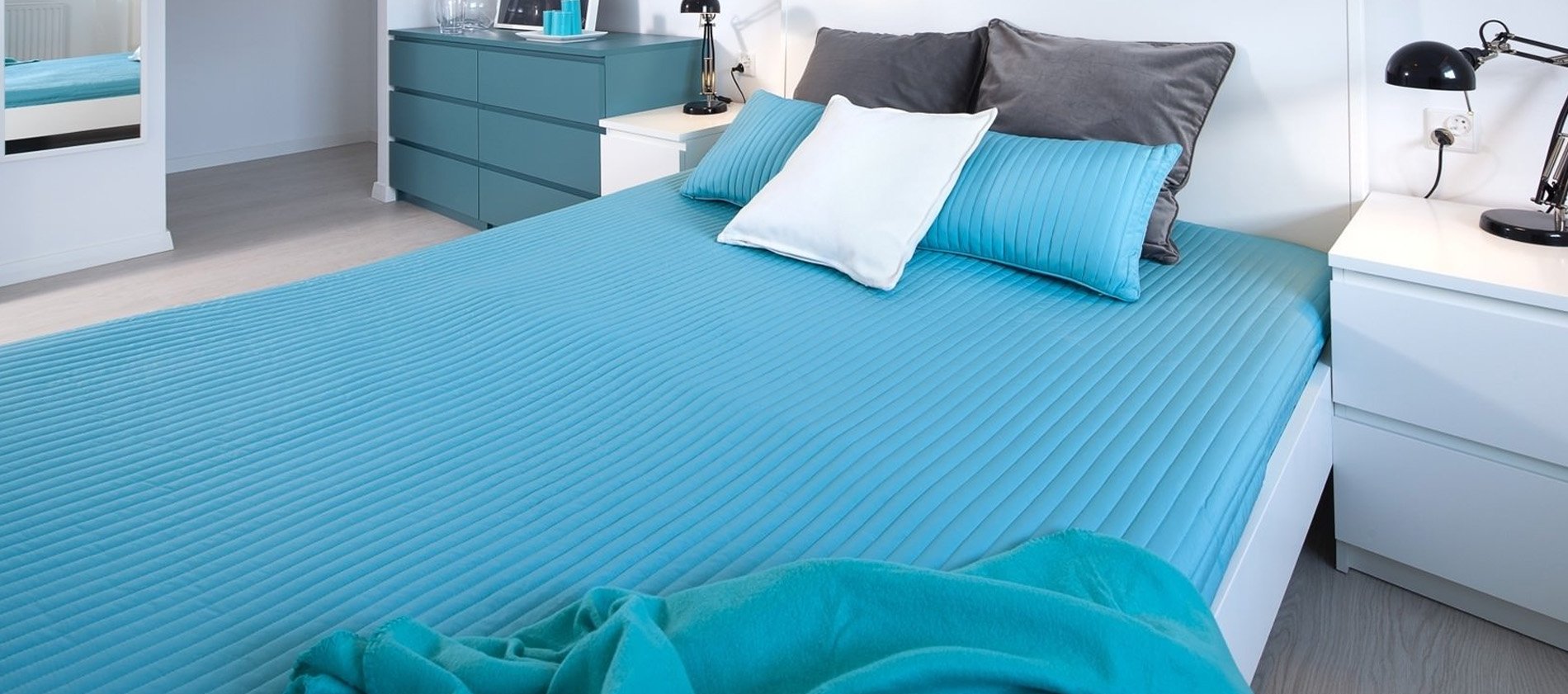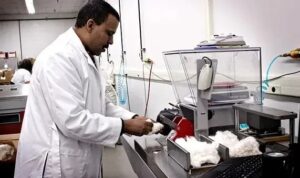How to make a mattress?
Mattresses are presently made of many materials, both natural and synthetic. The innerspring, helical, and boxspring components are made from wire; the boxspring wire is usually of a heavier gauge than that used in the innerspring. The insulator consists of semi-rigid netting or wire mesh, and the cushioning layers can comprise several different materials including natural fiber, polyurethane foam, and polyester. The flanges are made of fabric, and the hogs ring of metal. Top, bottom, and side panels consist of a durable fabric cover quilted over a backing of foam or fiber, and the binding
tape that holds the ticking together is made of heavy-duty, fibrous, synthetic material. The underlying boxspring may consist of either a wooden frame with slats or metal coils similar to those used in the mattress itself. The boxspring may be upholstered, but, even if it is not, it always receives a fabric covering.
History of mattress
Based on the available evidence, it is evident that the concept of bedding originated in ancient times. Early humans were able to enhance their sleeping comfort and effectiveness by lying on piles of leaves, straw, and animal skins instead of hard surfaces. As societies shifted from a nomadic, hunter-gatherer lifestyle to a settled, agrarian one, basic furnishings such as beds began to evolve.
To a significant degree, the evolution of the mattress is intricately tied to that of the bed. Throughout various ancient societies, the bed held significant importance as a focal point within the household, serving as a central gathering place for dining, relaxation, and sleep. Over the passage of centuries, bed frames grew increasingly ornate for the affluent, while mattresses themselves remained rudimentary and uncomfortable. Up until the twentieth century, mattresses primarily consisted of uneven pads filled with horsehair, cotton, or rags. Those of lower economic standing utilized fabric sacks filled with straw, corn cobs, or agricultural remnants. Despite their lack of sophistication, such primitive mattresses were challenging to cleanse due to the soil and insects that often contaminated the stuffing.
A pivotal advancement in mattress design emerged during the mid-1800s with the introduction of interior springs, which fundamentally transformed the feel and function of mattresses. By incorporating a standardized set of springs within layers of upholstery, manufacturers were able to produce mattresses with firm, resilient, and consistent support. However, the manufacturing costs associated with innerspring mattresses initially limited their availability to luxury establishments, such as upscale hotels and ships. It wasn’t until Zalmon Simmons, Jr., a prominent figure in the bedstead industry, commenced mass production of innerspring mattresses post-World War I that these mattresses became more accessible to the general populace.
To increase consumer willingness to invest in his innovative product, Simmons strategically marketed the benefits of a quality night’s sleep, a tactic that has proven to be highly effective over time. Today, modern mattresses are designed to enhance sleep comfort through various advanced features, such as improved innerspring technologies that distribute body weight evenly to prevent premature wear and tear. Furthermore, contemporary mattresses are crafted to provide optimal softness and flexibility to maintain the spine’s natural alignment during sleep, while avoiding excessively soft surfaces that can lead to discomfort and pain.
Presently, the demand for mattresses remains steady, with approximately 16 million mattresses sold in the United States in 1990, generating around $4 billion in retail sales when combined with foundations. While a few major companies dominate the market, the majority of mattress manufacturers are small, locally-owned enterprises. Of the roughly 825 mattress factories scattered across the country, many remain under the ownership and operation of their original founding families.
Design
Today, most mattresses are manufactured according to standard sizes. This standardization was initiated by the industry to resolve any dimensional discrepancies that might occur between companies that manufacture beds and companies that make mattresses. The sizes include the twin bed, 39 inches wide and 74 inches long; the double bed, 54 inches wide and 74 inches long; the queen bed, 60 inches wide and 80 inches long; and the king bed, 78 inches wide and 80 inches long.
The “core” of a typical mattress is the innerspring unit, a series of wire coils that are attached with additional wire. The upholstery layers are affixed to the innerspring: the first, called the insulator, is fitted directly onto the innerspring and prevents the next layer, the cushioning, from molding to the coils. While the insulator is fairly standard, the number of cushioning layers can vary widely in number, ranging from two to eight layers and from 1/4 inch to 2 inches (.63 to 5 centimeters) in thickness. Moving outward, the next component is the flanges, connecting panels that are attached to the mattress’s quilted cover with large, round staples called hogs rings. The top, bottom, and side panels of the mattress are stitched together with border tape.
While a wide variety of springs are designed to accommodate special needs and situations, the four most commonly used coils are the Bonnell, the Offset, the Continuous, and the Pocket System. The Bonnell springs are hourglass-shaped and knotted at both ends. The Offset design is similarly hourglass-shaped, but its top and bottom are flattened to facilitate a hinging action between the coils. The Continuous innerspring consists of one extremely long strand of steel wire configured into S-shaped units. Finally, in the Pocket System, each coil is encased in a fabric casing that also connects it to neighboring coil-casing units.
A typical mattress contains between 250 and 1,000 coil springs, and mattresses that use fewer coils normally require a heavier gauge of wire. It is not uncommon for an innerspring unit to require as much as 2,000 linear feet (610 meters) of steel wire. The individual coils can be joined in several ways. One common method is to use helicals—corkscrew-shaped wires that run along the top and bottom of the springs, lacing the coils together. Rigid border wires are sometimes attached around the perimeters to stabilize the unit.
Most manufacturers also produce foundation mattresses or boxsprings that lie directly beneath the mattress, resting on the frame of the bed. One of the most common types of box spring foundations uses a spiked coil configuration, in which the springs are narrow at the bottom but spiral to a wider diameter at the top. While a spring system provides the most common type of boxspring support, torsion bars are also sometimes used. Other foundation mattresses contain no springs at all but consist of a built-up wooden frame.
The Manufacturing Process of mattress
Building mattress layers
- 1 Most mattress manufacturers subcontract the production of the innerspring unit to an outside firm that specializes in making springs. Once the completed spring unit is received and inspected, the workers manually apply the insulator. Next, they apply the cushioning layers that will determine the feel and comfort of the final product.
- 2 While the mattress is being “built up” in one part of the plant, the decorative cover that will serve as the exterior for the top, bottom and sides are being made in another part. Usually, this cover is made on a giant quilting machine, which controls a multitude of needles that stitch the cover to a layer of the backing material. The stitching chosen serves both useful and ornamental purposes, as it must prevent the mattress cover from slipping or creeping over the layers of cushioning in addition to creating a visually pleasing exterior.
- 3 Once the fabric is quilted, it is cut into panels that will fit the top and bottom of the mattress. The side panels are often cut from this same composite or made separately on a border machine. If side handles or vents are to be added, they are attached to the side panels before these are applied to the mattress.
Attaching the flanges
- 4 Specially modified sewing machines are used to attach the flanges to the top and bottom panels, and the hog rings are stapled to the flanges. Everything is now ready for the closing operation, during which the hog rings will be secured to the innerspring unit.
Completing the mattress
- 5 The closing operation is one of the most highly skilled and critical procedures in the entire process. It is done with a movable sewing head that is mounted on a track. Tape edge operators manually feed the top, bottom, and side panels and a heavy-duty binding tape into the sewing machine as it moves around the mattress. As this combination of materials is fed into the machine, the operators use their skill to feed the proper amount of each material into the machine to produce a professionally tailored product.
- 6 Some of the highest quality mattresses may also feature a pillowtop, a panel filled with soft upholstery, and attached to the top and bottom panels of the mattress for a more luxurious feel and appearance. Prequilted, the pillowtop is then taped to the mattress.
Boxsprings
- 7 If the desired boxspring has a spiked coil design, it is made by stapling the bottom of each coil to a flat wooden frame. A wire grid is then placed on top of the springs and, once aligned, manually locked to them. A thin layer of upholstery is applied to the top. If the desired boxspring contains no springs,Once the cover is quilted, it is cut into the top, bottom, and side panels. Next, flanges are added, and hog rings are stapled to them. Finally, in the closing operation, workers use a movable sewing head mounted on a track to feed the top, bottom, and side panels and a heavy-duty binding tape into the sewing machine as it moves around the mattress. The mattress is then ready for packaging.
it consists of a wooden frame that may or may not have a layer of upholstery attached to its top. Regardless of the internal composition, the frame is usually inserted into a pre-sewn cover that encases the top and sides of the unit. A border fabric that matches the mattress exterior is applied to the sides, and a dust cover is added to the face.
Inspection, labeling, and packing
- 8 Once the units are complete, they are inspected for quality. If everything is in order, they are labeled with the content and the contingent “do not remove” tag, required by law to ensure the consumer that the contents are properly represented in the labeling. The finished product is then transported to the parking area. Here it is inserted by hand or by automated machinery into protective plastic or paper covers. Additional information about the warranty, safety, and care of the product is also included in the packaging.
Quality Control
During the manufacturing phase,, most quality control procedures are carried out by sight. The majority of manufacturers implement inspections at critical points in the production process: after receiving the innerspring, before the closing, and before packing.
Fire is a very real danger with all conventional mattresses, and the industry and the federal government have long sought ways to limit that danger. Since 1973, manufacturers selling in the United States have been required by law to make mattresses that resist ignition by cigarettes. In 1987, the industry voluntarily began to include tags on mattresses that warn consumers of potential fire hazards.
The Future
In recent years a great deal of research has been done on the relationship between effective sleep and the sleeping environment. Since comfort and sleep are to a great extent subjective, it is often difficult to quantify the results of such studies. However, many of the larger companies continue to spend a considerable amount of money on research, especially on the design of the innerspring. In these studies, quality and comfort are key considerations.
While traditional innerspring construction continues to account for the lion’s share of the mattresses produced in this country, both the water bed and the air mattress are gaining in popularity. While these unique designs require many different skills and production technologies, the growing demand for them over the last 20 years indicates a significant new trend.






